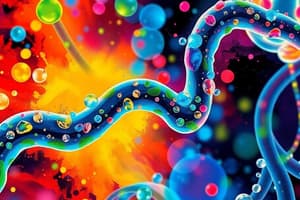Podcast
Questions and Answers
What is the primary purpose of bioenergetics in the human body?
What is the primary purpose of bioenergetics in the human body?
- To convert food into usable forms of energy (correct)
- To store nutrients in muscle tissue
- To regulate body temperature
- To facilitate oxygen transport in blood
What is the resting intramuscular concentration of ATP?
What is the resting intramuscular concentration of ATP?
- 10 mmol/kg
- 2 mmol/kg
- 8 mmol/kg
- 5 mmol/kg (correct)
Which macronutrient is the most calorie-dense?
Which macronutrient is the most calorie-dense?
- Carbohydrates
- Fats (correct)
- Proteins
- Vitamins
Which enzyme is responsible for converting glucose-6-phosphate to fructose-6-phosphate?
Which enzyme is responsible for converting glucose-6-phosphate to fructose-6-phosphate?
What happens to dihydroxy acetone phosphate (DHAP) in glycolysis?
What happens to dihydroxy acetone phosphate (DHAP) in glycolysis?
What is produced during Step 10 of glycolysis?
What is produced during Step 10 of glycolysis?
What biochemical event does lactate help counteract during intense exercise?
What biochemical event does lactate help counteract during intense exercise?
Which substrate is the starting substrate for the Krebs Cycle?
Which substrate is the starting substrate for the Krebs Cycle?
What is the net yield of Stage II (Conversion of pyruvate to Acetyl-CoA)?
What is the net yield of Stage II (Conversion of pyruvate to Acetyl-CoA)?
At what point is the lactate threshold (LT) observed?
At what point is the lactate threshold (LT) observed?
Flashcards
ATP Resting Concentration
ATP Resting Concentration
The amount of ATP stored in muscles at rest is about 5 mmol/kg.
Bioenergetics
Bioenergetics
The process of converting food into usable energy for our bodies.
Energy Investment Phase
Energy Investment Phase
The first 5 steps of glycolysis that require energy (ATP) to break down glucose into two G3P molecules.
Phosphofructokinase-1 (PFK-1)
Phosphofructokinase-1 (PFK-1)
Signup and view all the flashcards
Glyceraldehyde-3-Phosphate (G3P)
Glyceraldehyde-3-Phosphate (G3P)
Signup and view all the flashcards
Glycolysis Net Yield
Glycolysis Net Yield
Signup and view all the flashcards
Anaerobic Glycolysis (Fermentation)
Anaerobic Glycolysis (Fermentation)
Signup and view all the flashcards
Lactate Threshold
Lactate Threshold
Signup and view all the flashcards
Krebs Cycle Net Yield
Krebs Cycle Net Yield
Signup and view all the flashcards
ETC Net Yield
ETC Net Yield
Signup and view all the flashcards
Study Notes
Bioenergetics (Chapter 2)
- Metabolism is the total sum of all chemical reactions in the body, including energy involved in digestion and micro reactions.
- Two main types:
- Anabolic: synthesis or building of molecules. Examples include insulin's role in building adipose tissue (fat).
- Catabolic: breakdown of molecules. Example includes bioenergetics, the process converting food (fats, carbohydrates, protein) into usable energy forms at rest or during exercise.
- ATP (adenosine triphosphate)
- Not a long-term energy store. (~90 g total at rest)
- Resting intramuscular concentration is 5 mmol/kg.
- Muscle contraction can increase cellular ATP demand 500-1000x.
- Macronutrients:
- Proteins: 4 Calories/gram
- Carbohydrates: 4 Calories/gram
- Fats: 9 Calories/gram
- Carbohydrates and fats are the primary energy sources during exercise.
- Carbohydrates are more important for elite athletes.
ATP Production
- Enzymes are protein molecules that speed up reactions without being consumed.
- Enzymes lower the activation energy required for a reaction.
- The active site is where the enzyme's magic occurs.
- Enzymes can function both anabolically and catabolically.
- Two factors regulating the speed of enzyme activity:
- pH: Each enzyme has an optimal pH where it functions best.
- Temperature: High temperatures can denature enzymes.
- Energy systems:
- Phosphagen (ATP-PCR, Phosphocreatine): The first and shortest system, used during the initial seconds of activity (less than 3 seconds). Free-floating ATP is used.
- Glycolytic-Lactate: A second system using two types of pathways:
- Fast Glycolysis (anaerobic): utilized during short, high-intensity activities like plyometrics, weightlifting, or sprinting.
- Slow Glycolysis (aerobic): used in activities like walking, swimming, or cycling.
- Oxidative Phosphorylation (Mitochondrial Respiration): The third and most efficient system; used for longer duration exercise.
Anaerobic System
- Phosphagen system: uses phosphocreatine (PCR) to generate ATP, a one-step process involving creatine kinase.
- Anaerobic glycolysis: a two-step process with creatine kinase involved and negative feedback system when ATP levels increase, creatine kinase activity decreases.
- Creatine supplementation increases intramuscular stores of PCR, allowing for quicker energy release.
CHO Metabolism
- Four stages of CHO metabolism:
- Stage 1: Glycolysis (anaerobic) - breaking down glucose or glycogen into pyruvate to produce ATP. This stage has two phases: energy investment and energy payoff.
- Stage 2: Conversion of pyruvate to Acetyl-CoA (aerobic) - pyruvate is converted into acetyl-CoA to prepare for the Krebs cycle.
- Stage 3: Krebs Cycle( Aerobic) - Series of reactions where energy is harvested from Acetyl-CoA. Electron carriers NADH and FADH2 are produced.
- Stage 4: Electron Transport Chain (ETC) (Aerobic) - Electron carriers (NADH and FADH2) generate ATP via oxidative phosphorylation.
Aerobic Glycolysis
- Conversion of pyruvate to Acetyl CoA in the mitochondrial matrix.
- Pyruvate Dehydrogenase is the enzyme responsible for this reaction.
- The Acetyl-CoA is then used in the Krebs Cycle.
Other Important Points
- Lactate is a byproduct of anaerobic glycolysis.
- Lactate threshold is the point where lactate accumulation increases markedly, indicating a transition from primarily aerobic to anaerobic metabolism.
- Aerobic glycolysis and the Krebs cycle produce ATP through oxidative phosphorylation.
- Respiration quotient (RQ) relates how the body is burning energy.
Studying That Suits You
Use AI to generate personalized quizzes and flashcards to suit your learning preferences.




